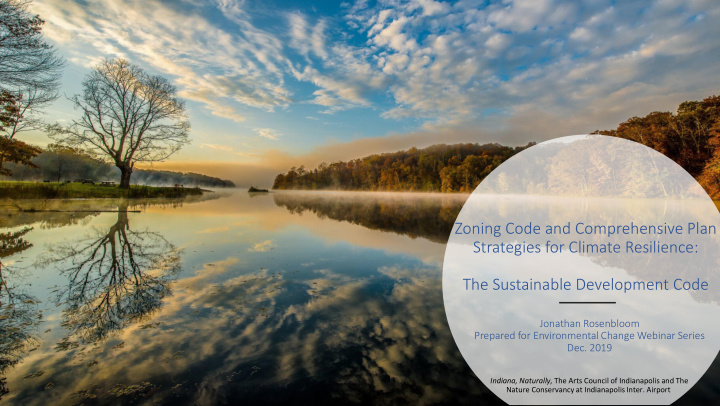



Zoning Code and Comprehensive Plan Strategies for Climate Resilience: The Sustainable Development Code Jonathan Rosenbloom Prepared for Environmental Change Webinar Series Dec. 2019 Indiana, Naturally, The Arts Council of Indianapolis and The Nature Conservancy at Indianapolis Inter. Airport
Development is Coming • 50-75 million people in U.S. population growth by 2040 • Will require approximately 90 billion additional sq. ft. of commercial/retail/ industrial space • Will result in nearly ½ of all residential housing to be new (about 80 million units) A RTHUR N ELSON , P LANNER ' S E STIMATING G UIDE : P ROJECTING L AND -U SE AND F ACILITY N EEDS ; Jennifer M. Ortman and Christine E. Guarneri, United States Population Projections: 2000 to 2050 , , Tbl. 1.
Where will this growth go? What will it look like? • Pursuant to existing development codes, land consumption outpaced population by 30-50% • At the low end (30%), by 2030, 40 million undeveloped acres will be destroyed to accommodate new construction • That is about the size of Indiana and Kentucky combined
Already Vulnerable Infrastructure “[T]he Nation’s infrastructure suffer[s] from chronic underinvestment, system failures and service shortfalls.” • National Infrastructure Advisory Council, Water Sector Resilience Final Report and Recommendations (2016). “[U.S. infrastructure] is in poor to fair condition and mostly below standard, with many elements approaching the end of their service life. . . . [T]he system exhibits significant deterioration. Condition and capacity are of serious concern with strong risk of failure.” • 2017 Infrastructure Report Card, American Society of Civil Engineers (2017) (giving U.S. infrastructure a D+).
Uncertainty . . . • Agriculture “Projected changes in precipitation, coupled with rising extreme temperatures . . . will reduce Midwest agricultural productivity to levels of the 1980s.” • Forests “threats from a changing climate are interacting with existing stressors such as invasive species and pests to increase tree mortality and reduce forest productivity.” • Human Health “climate change is expected to worsen existing health conditions and introduce new health threats.” • Biodiversity Climate change is contributing to species loss, including the extinction of the Karner blue butterfly in northern Indiana • Community Vulnerability and Adaptation “At -risk communities in the Midwest are becoming more vulnerable to climate change impacts such as flooding, drought, and increases in urban heat islands.” U.S. Fourth Nat. Climate Assessment, Chapter 21: Midwest.
. . . and Opportunity • In 2017, Indiana ranked 8 th among states in coal production and 2 nd in coal consumption, after Texas. • In 2018, coal fueled 69% of Indiana's net electricity generation. • Wind power provided about 5% of Indiana’s electricity generation in 2018, while solar, biomass, and hydropower combined accounted for slightly more than 1% of generation. U.S. Energy Information Administration, Indiana State Profile (visited Dec. 3, 2019).
www.sustainablecitycode.org
A Menu of 32 Subchapters: Sustainability in Development Codes
Climate Change, Chapter 1.1
Climate Change, Chapter 1.1
SDC: • Increasing Renewable Energy Production Four Ways to • Increasing Efficiency & Reducing Energy Load Think About • Increasing Sinks Local Climate • Maintaining Systems Action
Climate Change, Chapter 1.1: Increasing Renewable Energy Production
Zero Net t Energy Bu Build ildin ings Requirement of 2-10 watts per square ft, can be less if shown less energy is needed Requirements of solar ready area Efficiency requirements May apply to residential, commercial, and/or multi-family
Climate Change, Chapter 1.1: Increasing Efficiency & Reducing Energy Load
Maxi ximum Siz Size Sin Single le-Famil ily Resi sidence Heights over a certain dimension count more toward floor-area-ratio (ex. areas w/ 14 ft ceilings count 2x sq. footage) Setting a smaller limit on square footage (ex. max square footage at 2,300) Limiting footprint on lot (ex. 20% of lot)
Climate Change, Chapter 1.1: Increasing Sinks
Exp xpand Tree Canopy Cover Set canopy targets, such as increase by 40% by 2030 Establish “tree save areas” requiring setback Offer incentives for expansion of tree save area Afforestation requirements (ex. min. coverage such as 15%) Replanting of 10 trees for every 1 removed
Climate Change, Chapter 1.1: Maintaining Systems
Solar Energy, Chapter 7.2
Pedestrian Mobility, Chapter 4.3
Flood Plain and River Corridor Land Use, Chapter 2.1
Thank you! Jonathan Rosenbloom jrosenbloom@vermontlaw.edu (215) 760-8704
Recommend
More recommend